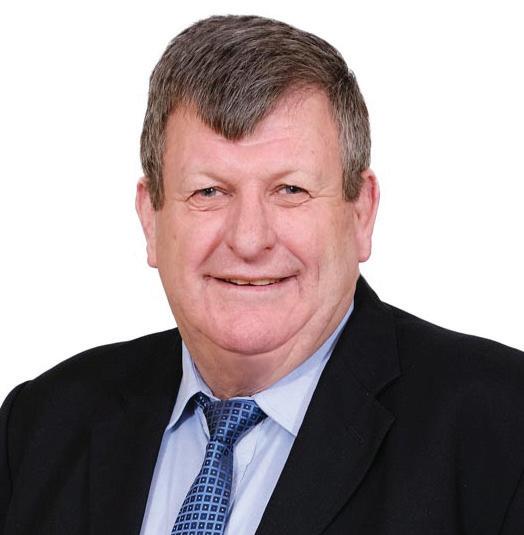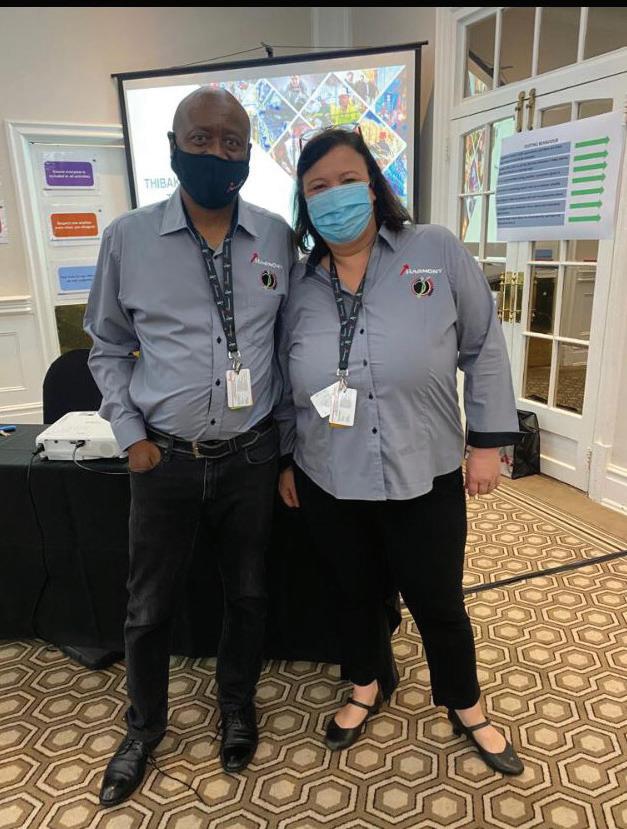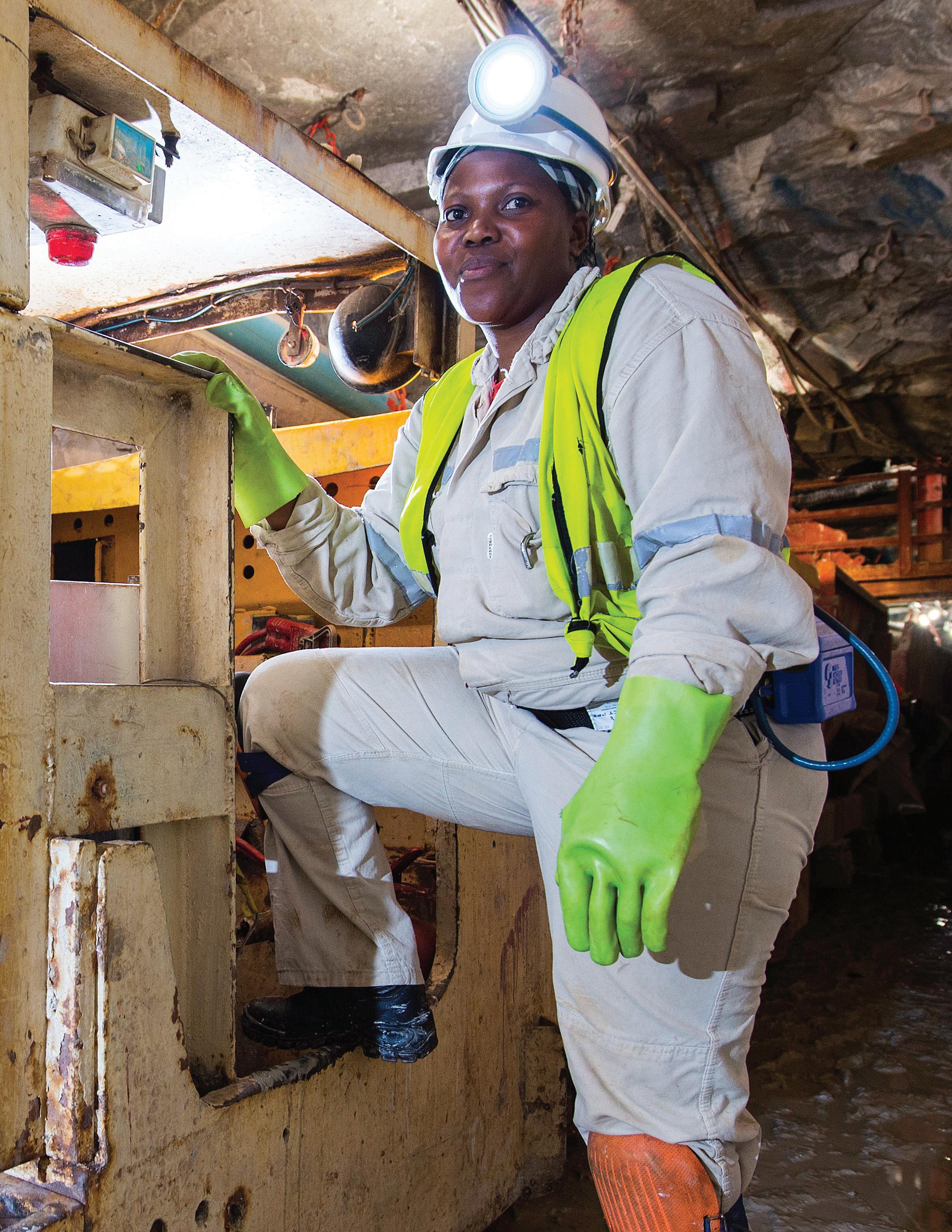
9 minute read
Being the first is a call to advance others
Dr Nombasa Tsengwa’s journey to becoming the first female CEO of Exxaro Resources is truly inspirational and offers valuable insights into the importance of diversity, equity, and inclusion (DEI) in the workplace. While her background is in environmental management, Dr Tsengwa has made a positive impact since joining the South African mining giant.
“The burden of all other women looking up to you as you advance, knowing that being first is challenging but crucial for others who follow.”
Dr Tsengwa’s leadership provides a blueprint for effective DEI efforts and emphasises the values and strategic alignment required for meaningful outcomes. Her approach underscores that true success in DEI is achieved when diverse staff members thrive in their roles, contributing to a culture where the benefits of diversity are evident in both individual achievements and organisational success.
“We have achieved our employment equity targets over the past five years. Although we have shown positive progress in achieving our annual targets, there are key challenges in the representation of women at senior management level and persons with disabilities across the organisation. We aspire to measure our transformation profile against national economically active population statistics.”
Dr Tsengwa’s achievements are even more profound given her rural background as a Black woman born during the apartheid era in the Eastern Cape. Recognising and celebrating this intersectionality is crucial in understanding the challenges she faced and the broader impact of her success in breaking down societal barriers. Her 20 years of executive management and board experience emphasise the importance of qualifications and competence in leadership roles. This counters the argument that diversity initiatives compromise meritocracy and debunks the narrative and misconception that promoting diversity equates to lowering standards.
She acknowledges the additional hurdles she had to overcome as a female CEO, emphasising the burden of being the first and the responsibility that comes with paving the way for others. This perspective sheds light on the unique challenges faced by women in leadership roles and the importance of mentorship and support systems. Dr Tsengwa’s proactive approach to understanding the mining industry by going underground in the mines demonstrates her commitment to breaking gender stereotypes and gaining first-hand experience. This is a powerful example of her dedication and being an example for others, contributing to her credibility as a leader in a male-dominated field.
People tend to look up to leaders and emulate them, especially when such leaders are perceived to have influence. Dr Tsengwa recognises the value of personal power and being heard, especially for underrepresented groups. Her leadership becomes a source of inspiration for women, youth, and Black individuals who may not have considered a career in the mining industry. Representation at the top is crucial for inspiring the next generation.
Exxaro Resources’ commitment to DEI is evident through its policies, skills development, and affirmative action measures. Dr Tsengwa emphasises the importance of aligning transformation objectives with national imperatives, reflecting a strategic approach to diversity and inclusion.
Dr Tsengwa’s unwavering commitment to her values is a fundamental aspect of her leadership. This characteristic is particularly important in DEI work, where staying true to principles ensures the sustained pursuit of fairness, equality, and inclusion. It sets an example for others to follow and reinforces the moral and ethical foundations of the organisation.
My take away lessons from Dr Tsengwa’s leadership
1. Inspiring excellence: She places emphasis on executing, pushing, and inspiring people to exceed their perceived limits, aligning seamlessly with the goals of DEI. Encouraging staff to achieve more than they believe they can fosters a culture of empowerment and growth. This approach benefits individuals and contributes to the overall success of the organisation by unlocking the full potential of its diverse talent.
2. High achiever with strategic focus: Her reputation as a high achiever who maintains focus on the vision and strategic goals of the organisation aligns with the idea that DEI is not just a standalone effort but an integral part of the broader organisational strategy. Integrating DEI into the overall vision ensures that diversity is not treated as a separate initiative but as a fundamental aspect of achieving long-term success.
3. Role modelling for DEI success: Dr Tsengwa’s leadership qualities serve as a powerful model for success in DEI. By excelling in her role and maintaining a strategic focus, she becomes a living testament to the positive outcomes of diversity in leadership. This serves as a compelling business case for DEI, demonstrating that a diverse and inclusive environment is not just morally right but also strategically advantageous for the organisation.
Click to watch Dr Tsengwa’s feature on Mining Review Africa channel
HARMONY’S TRANSFORMATION: A JOURNEY OF LEADERSHIP, EMPLOYEE ENGAGEMENT, SAFETY, AND FINANCIAL SUCCESS
Peter Steenkamp, Harmony Gold Mining
Peter Steenkamp has had a formidable 4-decade extensive career in the mining industry, having become Harmony Gold Mining CEO in January 2016 after occupying other executive positions at Harmony, African Rainbow Minerals and Pamodzi Gold. His previous position was with Sasol Mining as Senior Vice President. Peter has always believed in the importance of an engaged workforce and creating a conducive climate for safe production. As CEO, he maintained and accelerated existing programmes to uplift employees and establish a comprehensive organisational change programme.

During Peter’s tenure, his executive leadership team and management have embarked on a Humanistic Culture Change Journey to create a proactive safety culture. This culture is built from the principles of mature leadership, living the Harmony values, and ensuring a high level of engagement amongst the workforce. The aim is to create an environment where everyone lives the company values. The company really took time to focus on Values and it is a requirement that any initiative within Harmony points to the company values. They are embedded as part of its DNA. The Humanistic Journey is a comprehensive organisational change programme that includes the development of leaders themselves, providing skills and tools for leaders to develop others, and programmes for taking people along.
One of the important initiatives for taking people along is the bottom-up safety initiative titled Thibakotsi (translation: preventing accidents in seSotho) Team Training (TTT). This focused on crew and teams who work underground and surface employees to empower them to change their behaviours, live the Harmony values, challenge unsafe practices, and engage effectively with their leaders to ensure safe production. Part of Peter’s innovative endeavours is transforming Harmony’s talent pool into a stellar leadership team - the Harmony Leadership Development Programme (LDP), specifically customised to Harmony’s vision, business model and values.
This has been incorporated as one of the programmes to assist leaders in developing themselves in the Humanistic Culture Change Journey. Contrary to the usual approach where leadership programs focus on the first two or three levels of leadership, Peter and his executive team ensured that this programme is aimed at all levels of leadership. In our experience working with several organisations in mining and other industries, leadership programmes are often launched with much fanfare and later fizzle out because the organisation believes it is too costly or timeconsuming to cover all levels. Harmony’s leadership development programme includes everyone at all levels, prioritising cultural inclusion and transformation. The ambitious goal is to train about
2,500 leaders across all levels, fostering authentic leadership in the company.
By giving everyone a voice through the Humanistic programme, Peter fosters a sense of belonging and creates a culture of collective ownership of the organisation’s vision. The LDP has been running for over three years, and the Executive Committee remains committed to seeing it continue in future. The programme includes modules on leading self, relating to others, people leadership, business direction and business results. Senior and emerging leadership programmes are run jointly by the University of Pretoria and Mandate Molefi, with accreditation provided by the University of Pretoria. The junior and supervisory leadership programme is run and accredited by Maccauvlei Learning Academy. The LDP includes a vital module on Diversity, Equity, Inclusion, and Belonging (DEIB) during the Relating to Others module. There have also been several interventions around DEIB in operations to support the development of a culture of inclusion in MANCOMs (Management Committees) and teams. These interventions have focused on race, gender, generation, and other diversity markers.
Peter’s commitment to DEI is unmistakable. For example, he places emphasis on gender diversity by actively promoting women in mining. Under his leadership, numerous women have ascended to various leadership roles within the company, progressively breaking the barriers of traditionally male-dominated jobs in the mining industry. Peter and his team are aware of the ongoing challenges faced by women in a male-dominated industry like mining. His proactive efforts to support and develop women in the sector serve as an inspiration. As a leader who believes in visible, felt leadership, Peter is personally invested in the success of the Leadership Development Programme. Peter and his executive team are committed to attending the graduation ceremonies to support the graduates.
In a recent address to an enthusiastic audience at one such graduation, Peter shared his delight at the positive developments within the company. He began by highlighting the commendable operational performance, a testament to the collective efforts of the Harmony team. A significant achievement emphasized was the safety improvement in the company. This notable milestone was attributed to the entire Humanistic Culture Change journey, leading inclusively, addressing highrisk areas, and instilling a sense of responsibility and leadership at all levels of the organisation.
In conclusion, Peter expressed pride in the progress made and the positive changes observed within the company. There is a firm commitment to continuing the journey, sustaining momentum, and achieving further milestones.
Harmony’s journey is a compelling narrative of comprehensive and strategic organizational change underscored by DEIB, resilience, and an unwavering commitment to fostering a culture of authentic leadership and safe production.

My take away lessons from Peter’s leadership
1. Commitment to developing talent lies across multiple levels of the orgnaisation.
2. Adopting a talent management approach to DEI and ensuring well-curated leadership training for every level of the organisation.

3. Making sure that company performance and living the values are paramount to every employee’s day-to-day interactions at Harmony.
4. Going the extra mile to ensure that employees feel special, and constantly seeking ways of making Harmony an employer of choice.













